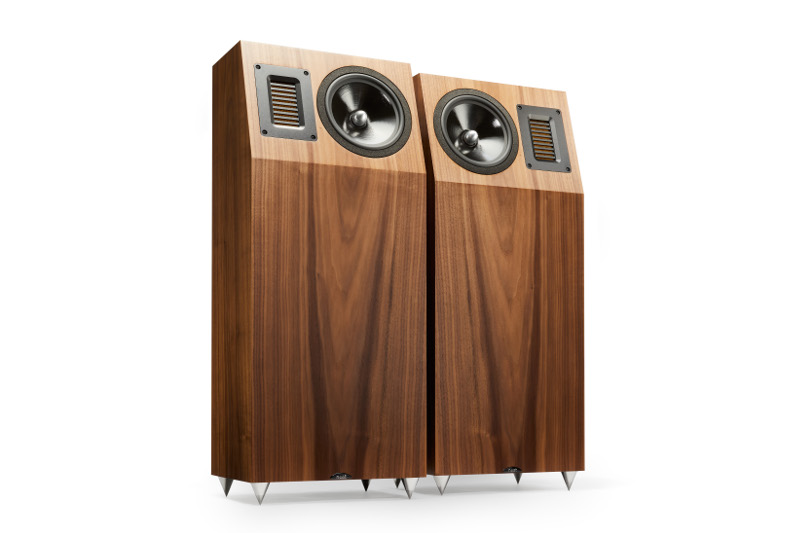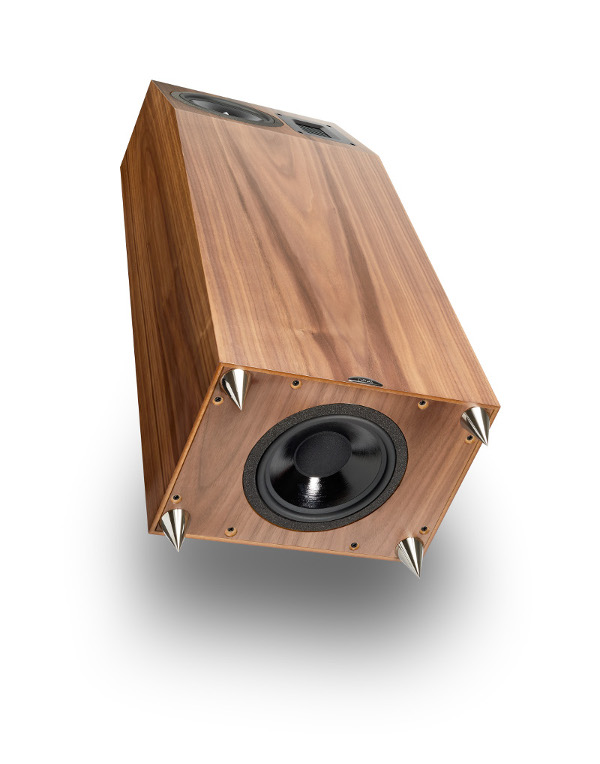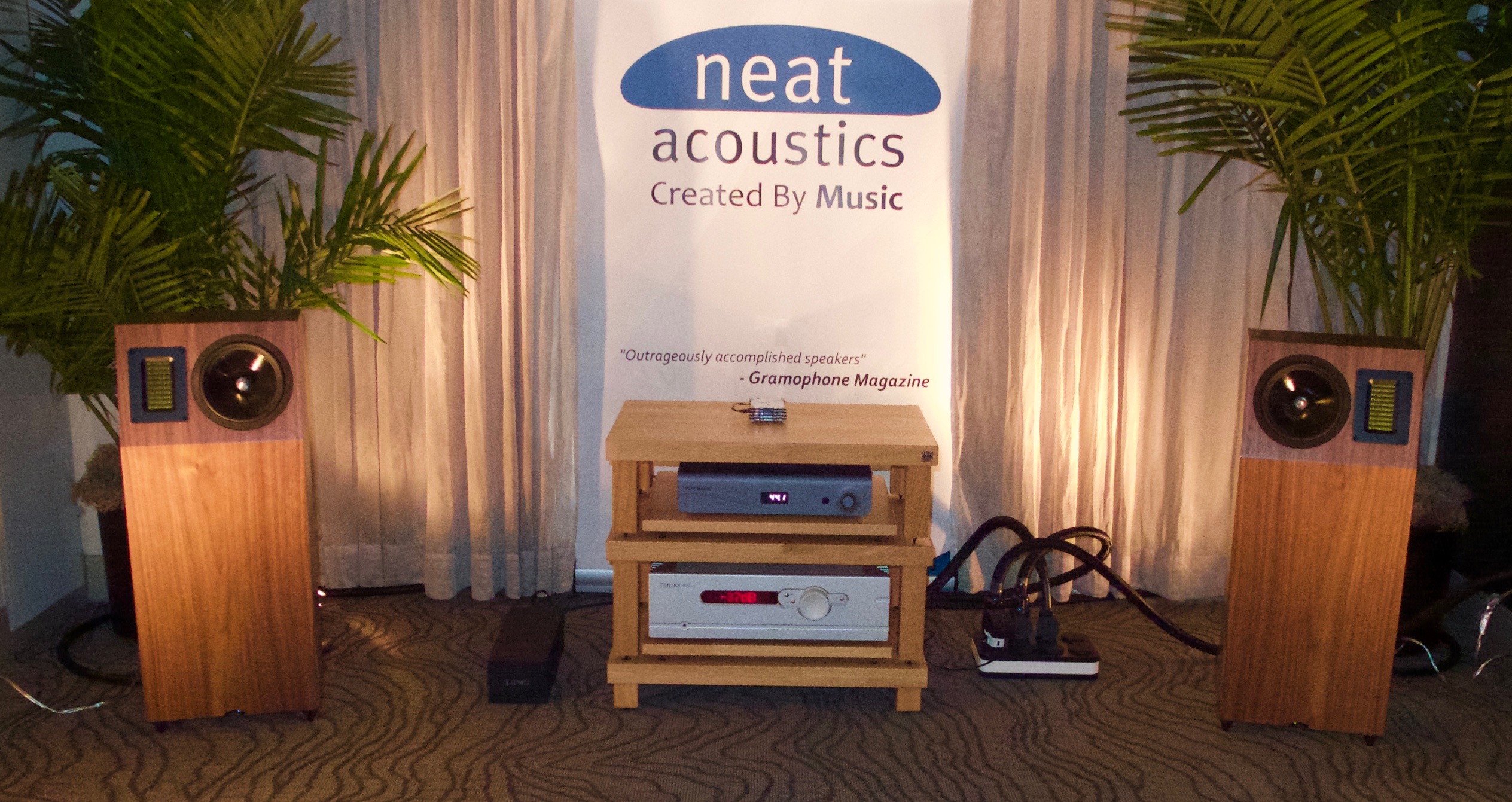
Last spring I reviewed NEAT Acoustic’s Iota Alpha speakers and fell in love with them in my upstairs, digital system and was very pleased with them in my reference system. The tiny Alphas just defy logic; how can a speaker that is this little be a floor-standing speaker, and how can they sound so big. The Iota Xplorer is a foot taller and 4 inches wider than the Alpha. Each speaker weighs 26 pounds more, and the pair costs more than twice as much. With the size difference, these speakers spent all of their review time in my reference system.
Description
The Xplorers stand 29 inches tall including the large conical spikes that leave an appropriate space between the bottom of the cabinet and the floor. The tall spikes were not an aesthetic decision; they are a necessity since the woofer is mounted in the bottom of the cabinet. From my listening chair, it looks like a two-way speaker since you can’t see the bass driver. If you look under the cabinet, you can see one of NEAT Acoustic’s P1-R2 6.5 inch drivers made with a treated paper cone. Though you can’t see it, there’s an identical driver above it within the cabinet in an isobaric arrangement.
Isobaric is a term that takes me back to the original Linn speakers of the seventies. It means one driver is mounted behind the other driver and moves in phase with the other one. So you have a two-motor system in a sealed chamber between the two drivers. In theory, this means that the system acts as if the overall enclosure is twice as big as it is. The lower half of the Xplorer’s cabinet is a separate chamber that is ported in the back. According to NEAT, it’s not a bass reflex port, but what they describe as a “controlled leak” that doesn’t augment the bass output in the way that a traditionally tuned reflex port does.
The top chamber is a sealed box, and it is internally partitioned so that the two drive units work in a two-way infinite baffle arrangement. This sealed chamber contains a P1/R3 6.5 inch mid/bass driver with a treated paper cone that has an aluminum phase plug. The tweeter is an air motion transformer driver instead of the EMIT tweeter used in the Alphas that I liked so much. This AMT tweeter is 4.5 inches tall by 2.4 inches wide. The cutaway diagram here will give you a better idea on the speakers’ construction.
The fit and finish of the speakers is first class. My review pair came in the black oak finish as you can see in the picture below. There are also available in a satin white, natural oak or walnut. The natural oak ones I’ve seen at the shows are my favorites in regard to looks although the black ones both visually and sonically disappeared in my reference system.
Setup and System

I started by placing the Xplorers in the same place where my Teresonic Ingenium speakers usually sit. And, I just hooked them up to the system as it was. At that time I was using a First Watt SIT-3 amp connected to an Emia Remote Autoformer. The rest of the system consisted of my AMG V12 turntable setup with a DS Audio Master1 Optical Cartridge and Phono Stage. I was also using a Border Patrol DAC and an Innuos ZenMini II music server.
I wasn’t surprised that just putting the Xplorers where my speakers had been didn’t work. I ended up moving them back until they were about 18 inches from the rear wall and about 30 inches off of the side borders. I toed them in until they pointed about 6 inches outside my shoulders. I tried them with the tweeters on the inside and on the outside. I preferred them on the outside, both for the soundstage and for the smoothness of the treble.
Positioning them as described also really improved the midrange and top-end and helped the bass. With this setup, the midrange was simply wonderful and the treble was very nice. The soundstage was huge, but neither the dynamics nor the bass were sounding as good as I thought they could. This wasn’t a surprise since the Sit-3 only puts out 18 watts, but I just wanted to hear the Xplorers with It.
I had two more powerful amps on hand, my Electrocompaniet at 100 watts per channel and the Pass Labs XA30.8. I tried both, and I wasn’t surprised that the XA30.8 sounded fuller and more powerful than either of the other amps. That’s because the XA30.8 is putting out nearly 60 watts of pure class A power into the Xplorer’s load. So, most of this review was done with the XA30.8, but I just had to go back to the SIT-3 from time to time, especially when listening to blues.
Listening

The sound of these speakers is quite different from the Iota Alphas. In my review of the Alphas, I said, If you have never heard a speaker that uses EMIT planar-magnetic tweeters, you are in for a real surprise, and it may take a few tunes to get used to the sound. A conventional silk-dome tweeter can’t match an EMIT’s wide-open, high-frequency sound and upper-range resolution. The difference is significant. They are magical when it comes to space; the sound literally floats above, behind and to the outside of the speakers.
The AMT driver in the Xplorers does not pull off this magic to the extent of the EMIT in the Iota Alphas. However, what it does do is play louder greater dynamics that fall somewhere between the EMIT and a conventional dome tweeter when it comes to producing that magical wide-open sound.
Like the Alphas, the Xplorers produce a sound that floats above, behind and to the outside of the speakers. Their placement of instruments and voices is very lifelike in that they are all part of the whole that floats around the speakers. I much prefer this kind of soundstage that you get from most multi-driver box speakers.
The Xplorers are more revealing and considerably more powerful both in terms of dynamics and bass drive than the Alphas. Neat Acoustics has done a great job on implementing the Isobaric loading of the bass drivers. I think the reason we don’t see more Isobaric designs is due to the cost of the extra drive unit and the difficulty in optimizing the cabinet. It is most unusual to get this kind of bass power and drive from a box that won’t dominate the room it is in. This speaker is not as refined sounding as the Alpha, but if you are trying to get more wow, drive and beat out of your system, they will do that in spades.
The last speaker I reviewed was the Legacy Audio Calibre. It also uses a similar size AMT driver for the treble. It is a three-way speaker that uses three drivers and two mass-loaded acoustic radiators. It is also similarly priced to the Xplorer. The Calibre is a monitor-type speaker, and though not a professional monitor in many ways, that one word sums up the difference in these two speakers. If you’re looking for the last word in transparency or resolution, then you might prefer the Calibres. The Xplorers are perfectly capable in these areas, but they are more about the musical experience rather than about hearing every little thing on the recording. I really like both speakers, but I will always choose the speaker that gives me the most emotional musical experience, and these little guys play music with so much passion.
I always spend a good bit of time listening to male and female vocals as well as piano music when doing a review. Voices, both male and female sounded natural, which is not so easy to do as many speakers that get the female voice right make the male voice sound thin. There wasn’t the least bit of a nasal tone or over-emphasis of sibilance.

Pianos, more than any other instrument, benefit from the coherency of a speaker. When listening to piano music, it was easy to hear both the attack and the decay for an appropriate time until the piano was played three octaves below middle C, and then there was a slight lag in the bass from the rest of the piano.
Listening to orchestral music on the Xplorers was different from listening to the Iota Alphas. They both projected both the flow of the music and the interplay of individual instruments with stunning realism, but the Xplorers add a lot of weight to the orchestra, which makes them sound even more realistic. The air around the instruments was not quite as good as with the Alphas, but the Xplorers were still able to float the entire orchestra above, behind and to the sides of the speakers. The sound was tactile and full-bodied with big tones that were rich and full of musical colors. The Xplorers’ sound was not quite as coherent from top to bottom as the Alphas. Still, orchestras were reproduced as a large and dynamic group of soulful musicians. I also really enjoyed the sound of Ellington’s band and other big band music over these speakers. The bass loaded the room in a way that made me feel like I was there listening to an Ellington band.
As I was listening to Peter, Paul, and Mary’s Carnegie Hall LP, I came to realize that in many ways these speakers remind me of the Quad ESL 63s but with more extended bass and treble and better dynamics. On both the Carnegie Hall LP and The Weavers Reunion At Carnegie Hall, the performers were in my room in all their glory spread across the stage and the hall and the audience was easy to hear and very natural sounding. These LPs give you a chance to listen to male and female vocals, and the Xplorers excelled with both. Again, the way they float the soundstage adds to the realism of the listening experience.
I also found the sound of Jazz instrumentals and vocals was exceptional on these speakers. The sound of strings on the Xplorers was sweet and extended. Strings sounded great on classical music, on a blues guitar, a stand-up bass in a jazz group or listening to rock music. The leading edge was fast, quick and dynamic. It doesn’t matter whether the strings were plucked, bowed or strung, they all sounded natural and beautiful.
The Xplorers reproduced the scale of a performance somewhat better than the Alphas and differently from the Legacy Audio Calibres in that they float a bigger image but without quite the power of the Cailbres. This quality in a speaker is something that is important to me when it comes to listening to recorded music, and I was very satisfied with the Xplorers. Like the Alphas, they have the wonderful way the NEAT speakers produce such accurate scale even at very low volume. Even better than the Alphas or the Legacy Audio Calibres, is the Xplorers ability to enable you to experience a real vertical soundstage that adds naturally to their sense of scale.
Conclusion
The NEAT Acoustic Iota Xplorer speakers are a very special audio product. Paul Manos, the importer of NEAT Acoustics, commented that when he thinks of the Iota Alpha speakers, he thinks of them as the “Anti-Audiophile Speaker.” Well, the Xplorers are both audiophile speakers and anti-audiophile speakers all in one box. To start with, because of their size, they look more like a real floor-standing speaker. When you listen these speakers, you discover you could listen to music on them all day long. It is shocking how they play a big pipe organ or orchestra by floating them in your room with real scale and space.
And, as I said earlier, the NEAT Xplorers are not about analyzing the recording but about enjoying the performance on the recording. Having said this, they are simply exceptional speakers!
TECHNICAL SPECIFICATIONS
ENCLOSURE TYPE: 2.5-way, iso-baric bass reflex, incorporating an integral iso-baric subwoofer
DRIVE UNITS: 1 ́ Neat P1-R3 170 mm LF/Midrange unit 1 ́ AMT HF unit 2 ́ Neat P1-R2 170 mm LF units
FREQUENCY RANGE: 25 Hz – 22 kHz
IMPEDANCE: 6 Ohm (minimum ~5 Ohm)
SENSITIVITY: 87 dB / 1 Watt
SIZE: (h x w x d): 30 x 12 x 9 inches
WEIGHT: 18 kg each (39.6 lbs)
FINISHES: American Walnut, Natural Oak, Black Oak or Satin White
Price: $5,150 (US)
